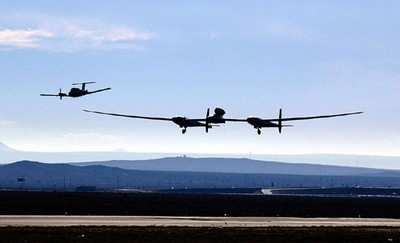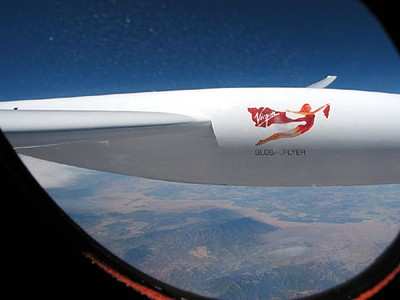It's A Delicate Matter -- Requiring Careful Planning And Just A
Little Chutzpah
When folks like us hop into our Cessnas or Pipers or Grummans
for a jaunt, fuel management is, of course, a major consideration.
How far, how high, with what winds and at what temperatures --
these are all things we have to consider before we undertake a
flight of as little as an hour. But imagine being on an
around-the-world record attempt that will last more than 70 hours
without the prospect of refueling. Can you imagine the nightmare
fuel management would become on that flight?

Steve Fossett can. He's getting ready to take the Rutan-built
Global Flyer on just that mission -- around the world in less than
80 hours... non-stop.
The Virgin Atlantic Global Flyer has considerably more to
manage. There are 13 fuel tanks in all. Just taking off will be a
hoot.
The aircraft will taxi to the end of a runway at the Salina (KS)
Municipal Airport. Waiting there, just short of the threshold, will
be a fuel truck to top off the tanks, replacing the fuel used just
to taxi out. The weight, part of a fuel management calculation, of
course, will be carefully checked to ensure the aircraft's narrow
wings aren't overloaded. When the wingtanks are full of fuel, the
wings themselves will droop to within a foot-and-a-half of the
ground.
The takeoff run will also be something to carefully watch.
Burdened to the very edge of its carrying capacity, the
single-engine Global Flyer will roll down the long, long runway,
slowly accelerating until it reaches flying speed. One mile down
the long strip, it will be rolling at 113 miles an hour. Just
before it reaches two miles down the runway, the Global Flyer will
reach 140 miles an hour.
At that point, according to the Salina Journal, the aircraft
will be just 1,500 feet from the end of the runway, traveling at
205 feet per second. Do the math. That leaves about a 16 second
margin of error as the Global Flyer and almost five tons of JP-4
lumbers into the sky.

It will be the first time so little plane has carried so much in
fuel. Five times its own weight, in fact. Its one reason Fossett
and his sugar daddy, Britain's Sir Richard Branson, chose the dead
of Kansas winter to make this flight.
"You have a much better chance of avoiding that kind of
instability (in winter) than during the summer months," Mary Knapp,
a climatologist at Kansas State University, told the Journal.
Even so, the strain on the plane will be remarkable. "One of the
most critical things they are going to have to do on takeoff is
avoid any turbulence that will add G-loads to the wing structure,"
said Ken Barnard, a K-State aviation professor.
The weight of the fuel, of course, leaves little margin for
adding more weight in the form of ice. But in spite of the fact it
will fly in the dead of winter, Global Flyer carries no anti-ice
gear. It's just one more example of how Fossett and, vicariously
through him, Branson, are living right on the edge of the
envelope.

As ANN reported last week, Global Flyer was supposed to launch
on Wednesday. Because of issues with the location of the jet
stream, however, the flight has been postponed until at least
Sunday.
 Samson Sky Hits the Wind Tunnel
Samson Sky Hits the Wind Tunnel ANN's Daily Aero-Term (05.22.24): LAHSO
ANN's Daily Aero-Term (05.22.24): LAHSO Aero-FAQ: Dave Juwel's Aviation Marketing Stories -- ITBOA BNITBOB
Aero-FAQ: Dave Juwel's Aviation Marketing Stories -- ITBOA BNITBOB ANN's Daily Aero-Linx (05.19.24)
ANN's Daily Aero-Linx (05.19.24) ANN's Daily Aero-Term (05.19.24): Back-Taxi
ANN's Daily Aero-Term (05.19.24): Back-Taxi





